Imagine a world where people are free to have conversations with any business, at any time, on their terms.
Imagine it was as easy to buy business services and products as it was to order food from your favorite restaurant on DoorDash or watch a movie on Netflix.
Sounds nice, right? Your buyers think so too.
Hi there, we’re Drift 👋
And we’re on a mission to empower businesses to deliver personalized experiences that turn into more quality pipeline, revenue, and happy customers. Drift’s Conversation Cloud brings together your marketing, sales, and service teams to create a consistent experience that engages buyers at the right time, in the right place, with the right conversation.
If you’re here, you probably have questions like:
- What is the Conversation Cloud and how can it help my go-to-market (GTM) team?
or
- How can my company make the most of our Drift platform right now?
Well, this book has the answers — whether you’re evaluating if Drift is right for you or you want to get more out of your Drift platform. In this comprehensive guide, you’ll discover a GTM strategy that uses Drift to unify all your GTM teams to deliver personalized customer experiences.
What Is Conversation Cloud?
Drift’s Conversation Cloud is a platform that breaks down the silos across your revenue teams so you can deliver a personalized experience at all stages of the customer journey.
In a nutshell, Drift’s Conversation Cloud helps make business buying more human by delivering the customer experience that today’s buyers actually want.
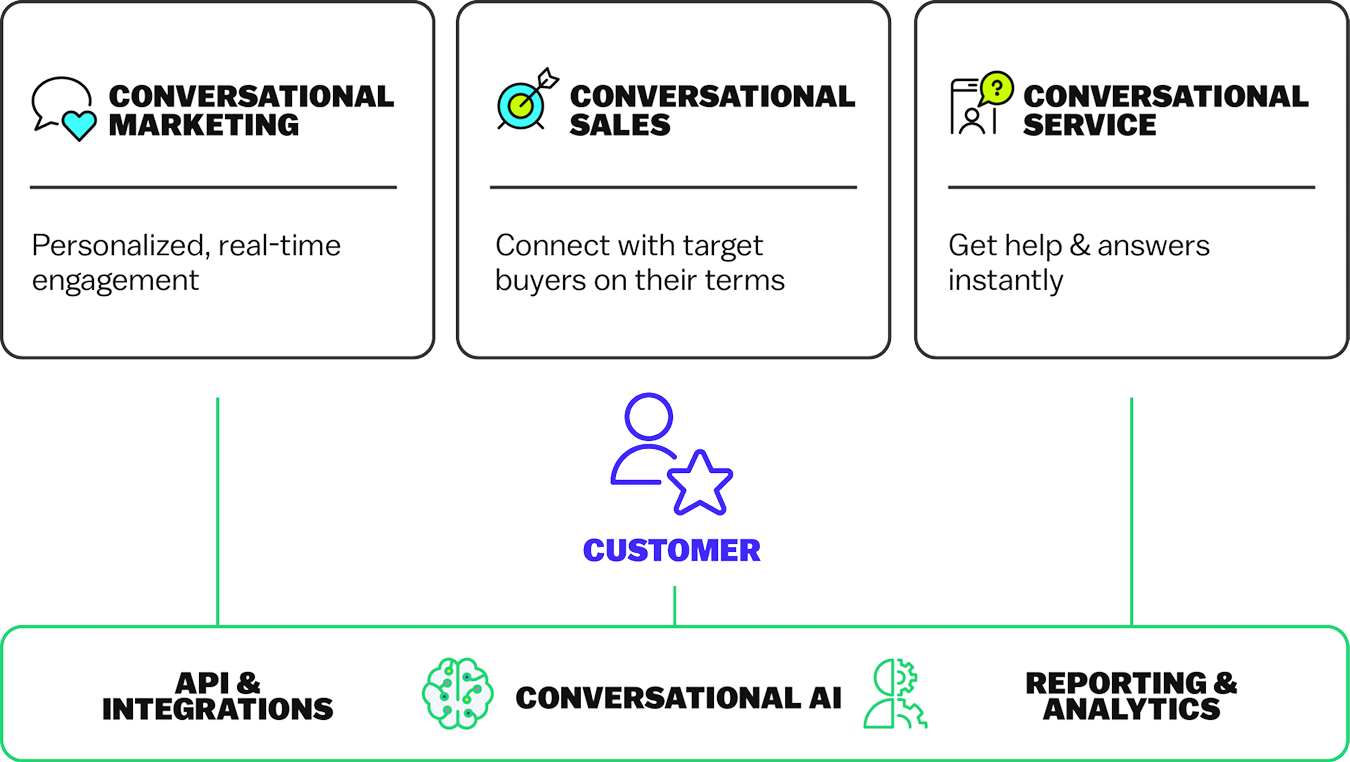
As buyers, more than 75% of us prefer digital self-serve and remote human engagement over face-to-face interactions. And no matter what stage of the customer journey we’re in, we want convenience, speed, and knowledgeable help.
Drift’s Conversation Cloud does this by bringing together Conversational Marketing, Conversational Sales, and Conversational Service so that you can make every customer interaction authentic, engaging, and valuable by harnessing the power of conversations.
All in all, Drift’s platform gives your buyers and customers the power to engage with you on their own terms, without losing the personal touch.

Drift’s Go-to-Market Strategy for Marketing
Your buyers and customers are now almost exclusively online. That means your digital experiences define your brand experience. To ensure your brand hits the right notes, your GTM strategy needs to double down on a buying experience that is engaging, personalized, and scalable.
☝️ That’s why so many marketers rely on Drift.
With Drift, marketing teams can not only scale real-time website personalization for all website visitors but also target key accounts and connect interested buyers with sales, instantly.
So instead of waiting for prospective buyers to fill out a form or spending time sifting through leads, marketers can focus on creating engaging campaigns that drive conversions and conversations — while delighting buyers along the way.
What is Conversational Marketing?
Drift’s Conversational Marketing solution makes up the first pillar of the Conversation Cloud and the part of your GTM strategy that’s focused on sparking conversations and connecting the right buyers with sales at the right time, using targeted messaging and content.
In today’s buyer-first world, when a customer visits your site, they expect an experience that is on par with their favorite B2C experience — something as easy as ordering dinner from their go-to delivery app or calling a car to their doorstep.
In other words, B2B buyers want to get value out of every interaction easily and quickly. In fact, in 2021, the demand for immediate responses on B2B websites grew 64% year-over-year.
Conversational Marketing powers the instant and personalized engagement that customers and buyers expect. It removes friction from the buying journey, so you can have conversations that generate revenue and — more importantly — customers can enjoy.
There are three steps to implementing Conversational Marketing, known as the Conversational Framework:
- Engage: Most buyers are forced to fill out long forms and wait for a response to download an ebook, sign up for a webinar, or even talk to sales. With Conversational Marketing, buyers can instantly access the information they need via chat on your website. And by integrating Drift with your customer relationship management software (CRM), marketing automation platform (MAP), or data enrichment provider, you can continue nurturing prospects across all channels.
- Understand: Before Conversational Marketing, the buyer qualification process involved a lot of complicated lead processing. But the beauty of real-time conversations is that you get real-time responses. With Conversational Marketing, you can learn who your buyers are and qualify them in real time.
- Recommend: Now that you’ve engaged with your buyers and understood how to direct them down the right path, you can use chat and other channels to:
- Connect to sales: Let buyers book a meeting or schedule a demo with the right sales reps using a seamless integration to their calendars. Or have your sales team engage with buyers instantly via chat.
- Nurture buyers further down the funnel: Buyers aren’t always ready to talk to sales. Use chat to navigate these buyers to the next best step — be it a solutions page, ebook, webinar recording, or support doc.
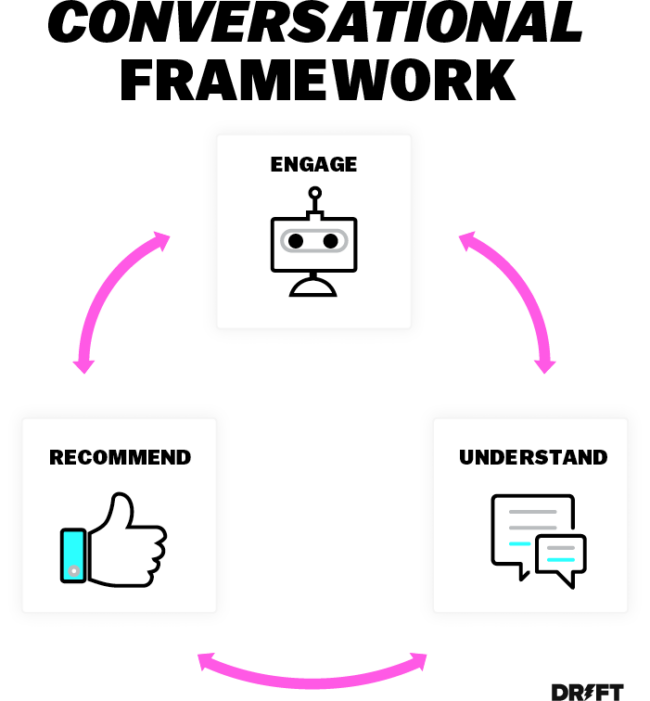
Using the Conversational Framework, marketing leaders can solve some of the greatest challenges facing their GTM teams — and create happy customers along the way.
Digital marketers are the maestros of your website. It’s their job to optimize your digital experience and landing pages to drive conversions. They’re the experts on developing playbooks (more on that later) and digital strategies for your campaigns.
Here’s how these marketers can get the most out of Drift:
Understanding Your Audience
Knowing “who” you are talking to is critical to starting meaningful conversations that drive opportunities.
Digital marketers use Drift Audiences to identify which pages are getting the most traffic, how many site visitors you’re engaging with, and how many of those people are converting into leads.
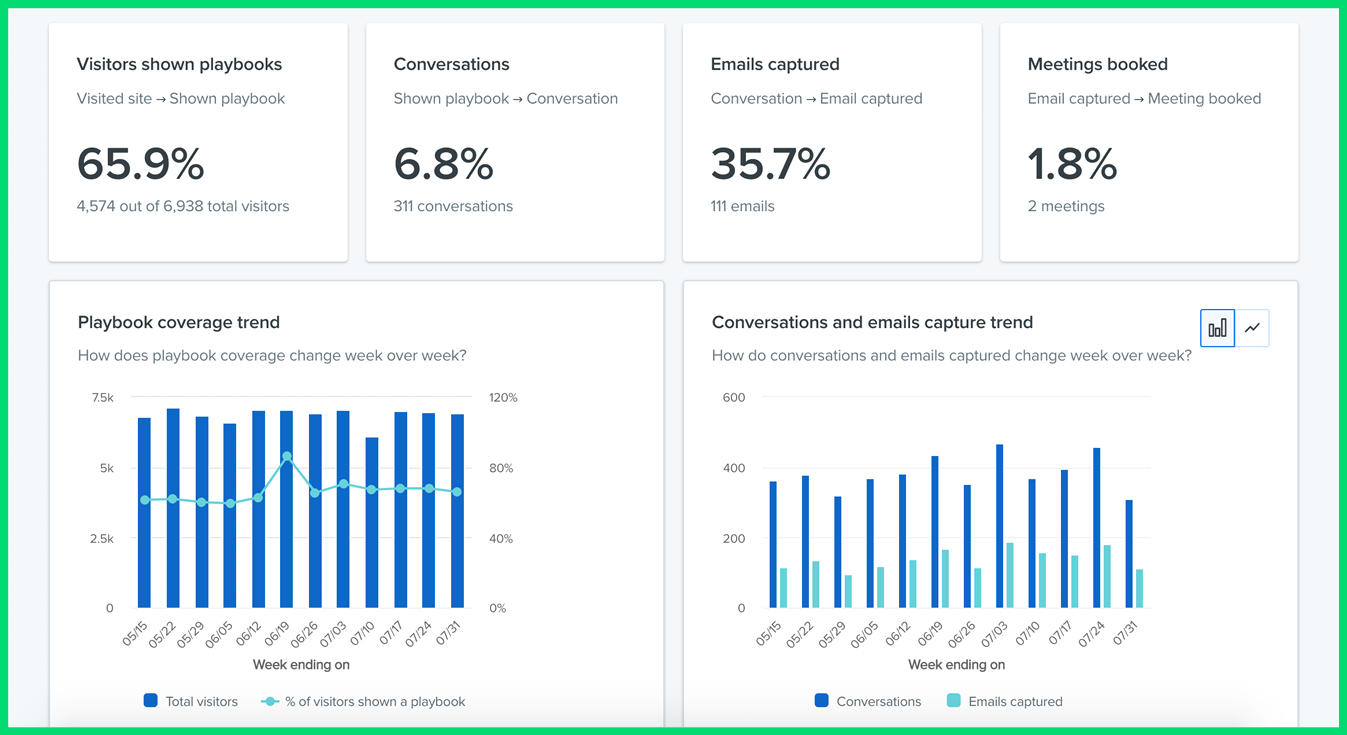
With this information, marketers can determine what pages need more coverage from your playbooks to increase website engagement.
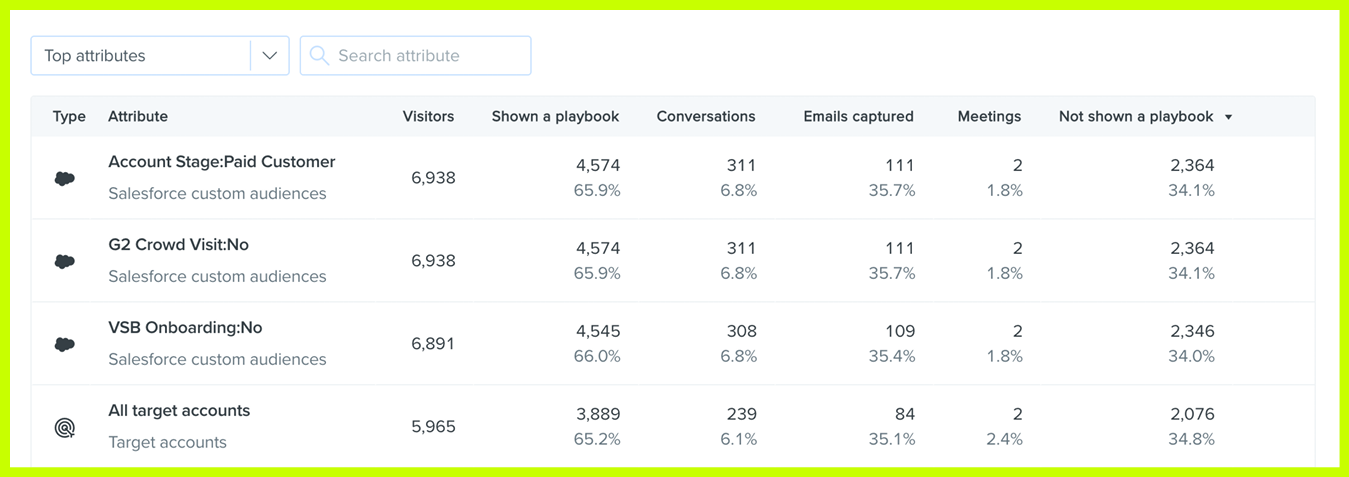
Digital marketers can also connect Drift Audiences to Marketo and Salesforce Account Engagement (formerly Pardot) to see which target accounts are landing on your company’s website and engaging with your playbooks. This is a great way to ensure you’re tailoring your digital experience for your top-tier buyers.
“Drift Audiences is a great tool to help understand these audiences and where they are coming from. If someone is coming from a paid ad for instance, we want to keep the experience and language consistent with that.”
— Stacy Chen, Owner, Drift for Drift
Customizing Messaging Based on Buyer Journey
Not all web pages are created equal. If a buyer spends more time on, say, a pricing page, that could mean they are actively evaluating your business and may wish to speak with sales.
Reaching out to buyers when their intent to buy is highest is critical to increasing conversions from website traffic and marketing campaigns.
But what you say in these moments is important too. You want to develop the right messaging based on where buyers are in their buying journey, and then leverage your cohesive GTM strategy to apply that messaging throughout the funnel.
Using the Conversational Marketing Blueprint, you can develop messaging use cases for different touchpoints in the buyer’s journey. These use cases can include playbooks, emails, and video messaging. (At Drift, we use the term “playbook” to refer to different types of bots you can set up in the backend — from commonly used chatbots to Conversational Landing Pages.)
Let’s look at a few playbook use cases.
Engage with Website Visitors
A great way to deliver a more personalized digital experience is to greet visitors with a custom chatbot. And that’s what the first stage of the Conversational Marketing Blueprint, Engage Website Visitors, is all about.
This stage starts off with the Engage All use case, which you can think of as your “default” website experience. It’s your go-to playbook when other high-priority use cases, like a pricing page, don’t apply. You can tweak and refine this use case to create different experiences, such as for your blog or solutions pages.
Your goal with this use case is to engage visitors quickly and kickstart the conversation. So the copy you use needs to jump out and grab their attention.
Here are some ideas you can use for a chat playbook:
- Hey there 👋 Can I ask you a quick question?
- Hey, [company name]! Can I help you find something?
- Want to know something cool? 👀
In this example, Gong engages the website visitor with a cheeky hook that draws in the site visitor.
Target Potential Buyers
In the Engage Website Visitors stage, you cast a wide net in order to start conversations with your website visitors. On the other hand, the Target Potential Buyers stage is about homing in on specific buyers with a more personalized experience. These buyers could be target accounts from an ABM campaign or visitors showing strong signs of buying intent.
For example, with the Persona Targeting use case, the goal is to draw in potential buyers by referencing information about their industry. Here’s a list of eye-catching openers you could use for a chat playbook:
- Hey [Name] 👋 Welcome! Want to speak to someone about the challenges facing [JOB TITLE]?
- Hey [Name] Welcome to [Site Name]! Can I ask you a quick question about [Industry]?
- Hey [Name] 👋 Welcome to [Site Name]! Want to learn more about solving [Industry problem]?
In this example, PTC engages the site visitor by offering a fast track to speak with an industry expert.
Accelerate Deal Cycles
The third stage, Accelerate Deal Cycles, delivers deeply personalized experiences tailored to individual buyers. At this stage, you’re looking for people coming to your website in a buying mindset, and you’re helping them find answers, support, or products and services as quickly as possible.
With this type of chat playbook, your bot can step in and handle all frontline interactions — from answering qualifying questions to booking meetings for your sales team.
In this example, Okta engages the site visitor by recognizing they are returning to the site and uses that context to add humor saying, “Things must be getting serious!”
Increasing Marketing Return on Investment (ROI) from Digital Advertising
If you’re using digital advertising to drive people to your website and offers, it’s important to optimize that experience as well.
Drift improves conversion rates on your website by making it easy to retarget and customize digital advertising experiences for visitors from paid ads. Whether buyers land on your website from LinkedIn, Instagram, or Twitter, you can make sure they receive an experience tailored to them.
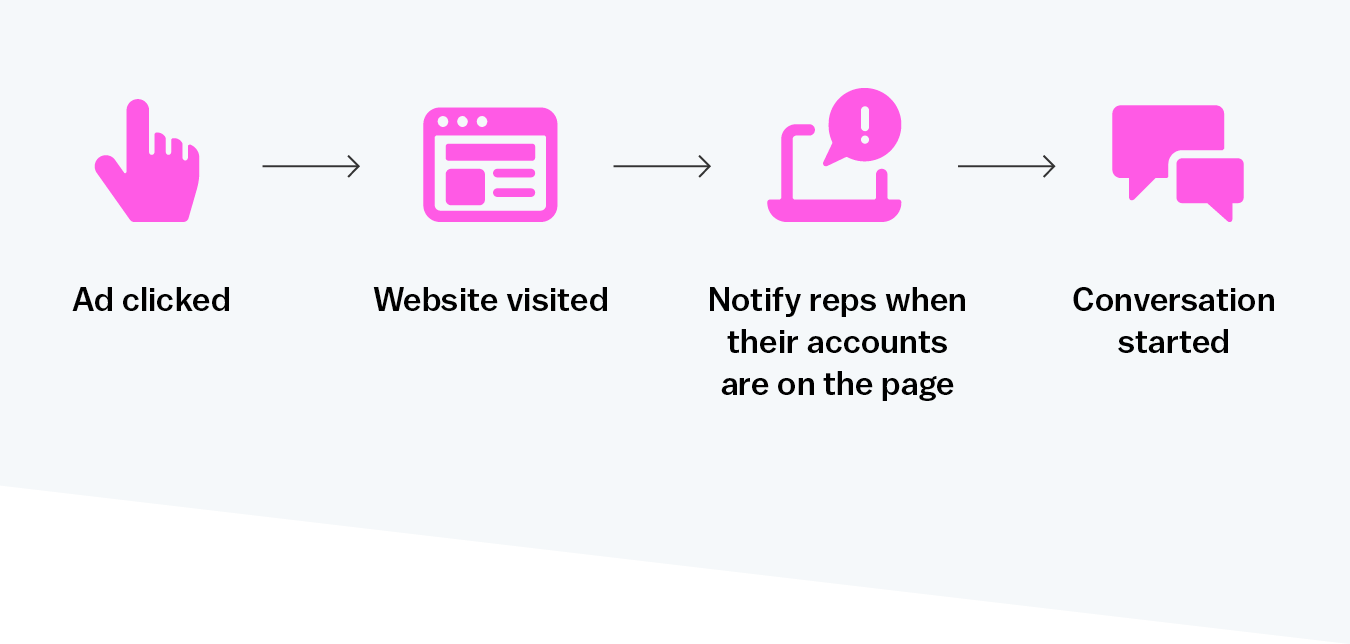
Once that buyer comes to your site and starts a conversation, you can leverage Drift’s two-way integrations with CRMs and MAPs to customize messaging without the need to create more landing pages. Meanwhile, with each engagement, you can update your MAP with conversational data to more effectively nurture buyers on other channels.
These integrations allow you to level up the personalized experience by greeting target accounts by name. On top of that, you can use UTM parameters to customize chat messaging based on the source channel. So, if a VIP buyer comes in from a Google search ad, they might see this 👇
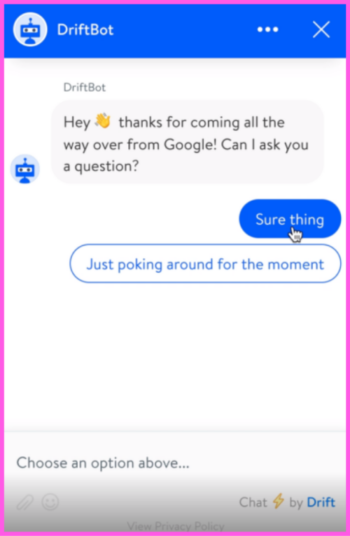
You can also use Drift Intel to draw on buyer information for more tailored conversation and route qualified leads to the right sales rep based on the buyer’s region, company size, and more.
“It’s not set it and forget it when it comes to Drift. We always A/B test everything from bot copy to hooks to CTAs to make sure we’re creating the optimal experience and hitting our goals.”
— Stacy Chen, Owner, Drift for Drift
As digital spaces and platforms grow in popularity, marketers need to focus on ways to stand out. Using Drift, digital marketers can easily scale personalized messaging, create engaging website experiences, and convert more opportunities from web traffic and campaigns.
Drift for Demand Generation
While digital marketers are in charge of steering the digital experience, they can’t do it alone. Demand generation marketers are the engine behind your marketing campaigns — they strategize the best ways to build brand awareness and turn leads into customers.
Here’s how demand gen uses Drift to execute integrated marketing campaigns across all your channels and lay the foundation for a unified GTM strategy:
Talk to Buyers in Their Own Words
At the end of the day, regardless of what industry you work in or what product you’re selling, what you’re trying to achieve is a conversation between two humans. But how can you do that without hiring hundreds of people to man your chat inbox?
Drift’s Conversational AI allows customers to have flexible, human-like conversations, without the need for a person on the other end. Customers can voice their questions and intent in their own words and get personalized and relevant responses in real-time. And the best part? Your buyers can chat or book a sales meeting at any time because Conversational AI is available 24/7.
Here’s how demand gen marketers can leverage Conversational AI:
- Speak your buyers’ language: Use your buyers’ words to create the right experience for each visitor — like nurturing qualified leads towards conversion, creating VIP experiences for named accounts, and allowing customers to get answers to their questions.
- Grow revenue more efficiently: Not every buyer that starts a conversation on your website is ready to buy. You can grow revenue more efficiently by automatically deflecting unqualified leads and customers from your sales team so they can focus on priority prospects and customers.
- Surface key buyer and customer insights: Conversational AI reads between the lines, surfacing key insights that your team can use to further tailor the buying experience. For marketers, this data is a gold mine that translates into better messaging that resonates with buyers — and turns into revenue.
Offer a Fast Track to Sales
Let’s face it — no one likes to be kept waiting. It stands to reason then that if a high-value account shows up on your website, the last thing you would want is to keep them waiting hours and days after they’ve filled out a form.
With Drift Fastlane, that’s no longer a problem. Now, you can qualify buyers as they are filling out your form and connect the most qualified ones with your sales team. So, if you’re not ready to give up forms as part of your demand gen strategy, Fastlane lets you ease into the transition.
Level Up Your Webinar & Event Experience
Webinars and events are a huge magnet for potential buyers, which is why they are a key part of many demand gen strategies. But marketers often struggle to drive attendance to these events — and keep up interest once attendees are there.
Drift supports two major use cases for marketers looking to solve these issues:
- Drive registrations to events and webinars with a dedicated chatbot: Increase registration for (physical and virtual) events and webinars by forgoing sign-up forms and automatically signing up attendees in chat. Learn how Celonis used Drift to grow event attendance by 7x.
- Engage with buyers during events: Integrate Drift with a virtual event platform, like ON24 or Goldcast, to engage with attendees during a live event. You can easily answer questions, schedule a demo, or even route in a sales rep while the session is ongoing. See how Drift starts conversations during virtual events.
“At Drift, we not only use Drift for pre-event registration, we also use Drift at in-person events so we can book meetings in real-time and when we’re on top of mind.”

— Blake Rubin, Demand Gen Associate, Drift
Generate More Conversations & Conversions from Content
Gating content behind long forms is a poor buyer experience and is sure to hurt your conversion rates. Using Drift chatbots, you can make it easy to download offers like ebooks while someone is on your website — as easy as having a conversation.
“Here at Drift, we create hyper-personalized landing page experiences. We nurture prospects throughout the bot experience, offering them relevant pieces of content and next steps.”
— Blake Rubin, Demand Gen Associate, Drift
These chatbots also allow buyers to ask questions before downloading content. And with Drift’s Conversational Content, they can also chat while consuming the content too.
In this example, Lessonly engages the website visitor by offering to pass over a PDF version of the content they are reading to their inbox.
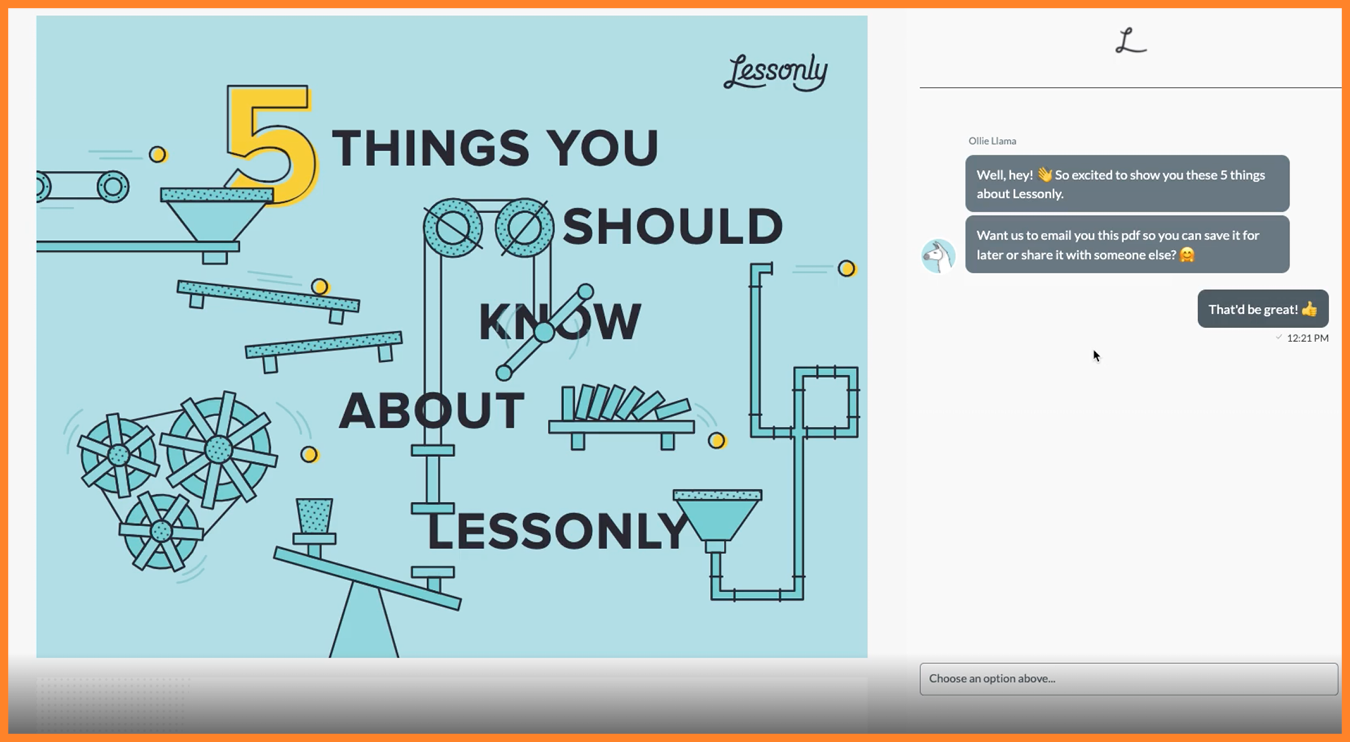
Drift for Account-Based Marketing
Account-based marketing (ABM) is a form of marketing that uses highly-targeted, personalized campaigns to win over key accounts. It starts with creating a list of high-value accounts and then rolling out the red carpet to give buyers a VIP experience — across your website and in every engagement you have with them.
This high degree of personalization results in more meetings and conversations for your sales team, which makes it a key component of any GTM strategy. But a personalized approach like this can be expensive and time-consuming.
“For our target accounts or high-value prospects, we create the most robust site experience…most importantly, we make sure routing is set up to alert the account owner as soon as a high value prospect is on the website so they can start a conversation or book a meeting.”
— Stacy Chen, Owner, Drift for Drift
With Drift ABM, marketers can easily personalize website experiences for target accounts and instantly connect accounts to their assigned reps.
GTM Strategies for Connecting Target Accounts to Sales
A marketer’s job doesn’t end after bringing high-value visitors to your website. You also need to partner with sales to convert those VIP buyers into customers.
By integrating Drift with your MAP or using Drift Intel, you can reach out to contacts from target accounts with a personalized message that is designed to spark a conversation. You can then notify the right rep that their target account is on the website so they can jump in and engage. And if your sales rep isn’t available, no problem; Drift Conversational AI can book meetings and demos for your sales reps (even while they’re sleeping).
Once you’ve set up your Drift workflows, you can start developing ABM campaigns and use Drift to have engaging and valuable conversations at every touchpoint.
Conversational Marketing makes it easy to create a buying journey that is both customized and designed to generate revenue. Whether you are speaking to a first-time visitor or a target account, you can tailor their experience to make it seamless — while still getting results.
Drift’s Go-to-Market Strategy for Sales
Today’s buyers have more resources and more options than ever before. It’s estimated that more than 70% of the buyer’s journey is completed before even talking to sales.
So where does that leave your GTM strategy?
A sales rep’s number one job is to help buyers find solutions to their problems. They are a buyer’s tour guide, on-call expert, and trusted advisor throughout the entire buying journey.
This means that you can no longer expect to move buyers through a complex sales process designed around your company’s needs. Instead, you need to put the buyer at the center of your GTM strategy to deliver a sales experience that people will love — and for that, you need Drift and Conversational Sales.
Drift’s Conversational Sales capabilities take a customer-centric approach to sales. Instead of waiting for buyers to come to you, you take the first step and engage them on their channel of choice — when they want and how they want.
But Conversational Sales doesn’t just make it easier for buyers to buy. It also makes it easier for sellers to sell by enabling sales development representatives (SDRs) and account executives (AEs) to:
- Easily engage with buyers across channels
- Identify key stakeholders
- Focus on the activities and deals that drive revenue
Like Conversational Marketing, Conversational Sales helps sales teams:
- Engage with buyers on their terms when their attention and buying intent are at their highest.
- Understand buyers by asking questions, tapping into intent signals, and using other sources of data to figure out what they care about and why they should purchase your product.
- Recommend what’s best for the buyer to educate them, build trust, and help find the right solution for them.
Drift for Prospecting
SDRs are the bridge between marketing and sales, which makes them invaluable to the success of your GTM strategy. They work with marketing to follow up on campaigns, align with AEs on buyer research, book meetings to turn conversations into opportunities, and a whole lot more.
SDRs also hear a lot of “no’s” throughout their day. This means the more of a competitive advantage you can give them, the better.
Here’s how your SDRs, business development representatives (BDRs), and frontline sales team can use Drift to break through the noise and start conversations with buyers.
Engaging Website Visitors in Real Time with Live Chat
Your team is most likely prospecting into accounts through a combination of emails, phone calls, and LinkedIn outreach. All three motions require you to wait for someone to respond. So you want your SDR team ready to do just that — respond to buyers when they’re ready to talk to you.
Drift Live Chat gives SDRs a way to engage with prospective buyers in real time. Live chat instantly notifies reps when a target account is on your website. If a rep is not available, the Drift chatbot can book a meeting for them in their stead. But if they are, then they can jump in and start a conversation via chat or take a call with Chat to Call and Chat to Zoom.
Whatever your buyer prefers.
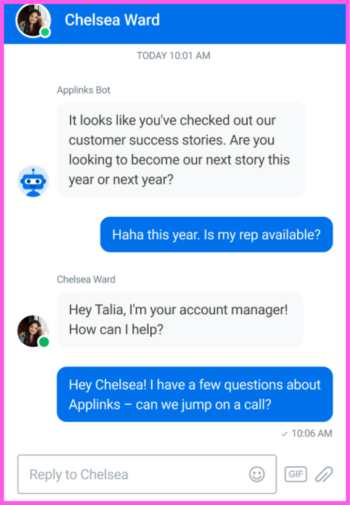
Personalizing Sales Prospecting & Outreach
Standing out among the hundreds of emails clogging up your buyer’s inbox is hard work. That’s why it pays to get creative in your cold outreach and sales prospecting.
Drift Prospector and Drift Video are two powerful features SDRs use to craft personalized outreach.
With Drift Prospector, you can take a deep dive into your target account’s activity. These insights help your sales team be more productive by engaging with the right people at the right time. Plus, Drift Prospector provides a single interface to analyze target accounts, draw on buyer insights, and directly access any follow-up.
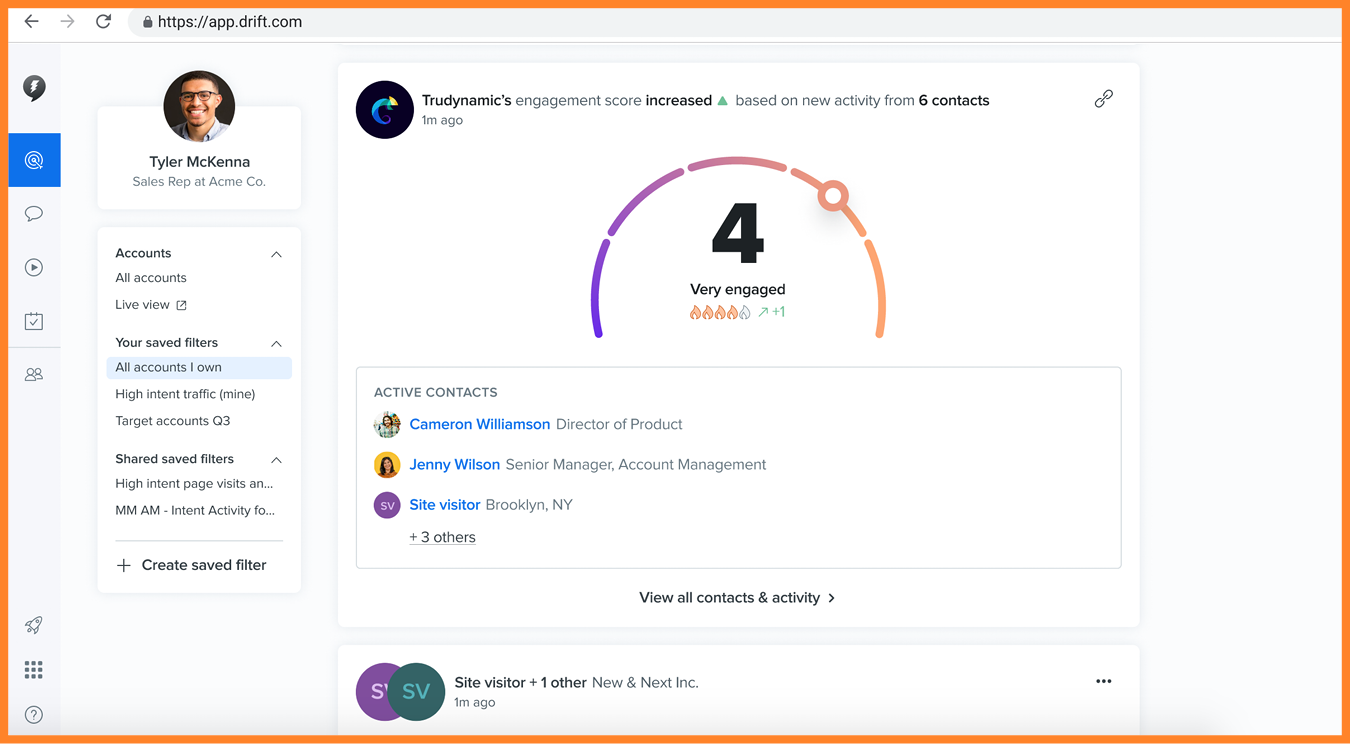
“Prospector is giving me ideas for my outreach. If I see someone is checking out a case study on our website, for example, I am going to use that in my outreach.”
— Paul De Libero, Enterprise SDR, Drift
Here’s how Drift Prospector can work for you:
- Prioritize your target accounts based on a comprehensive engagement score. Drift Prospector brings together information about how often contacts are engaging with you, what they are engaging with, and how recently they engaged with you to create a score that lets you easily identify your most engaged accounts.
- Identify decision-makers so you know who to reach out to, who is most interested, and who is currently on your website.
- Know what to say in each conversation based on a contact’s LinkedIn profile, Salesforce history, past Drift conversations, and what content the buyer has already consumed.
- Capitalize on buyer intent by taking action quickly when a buyer has expressed interest or intent to buy.
Drift Prospector also allows you to quickly start a conversation — whether it’s enrolling someone in a nurture sequence, initiating a chat, or reaching out via Drift Video.
Drift Video helps you answer complex questions in less time than it takes to type out a long email, while adding a face to your name. And, even better, you can get notified when someone is watching your video so you can chat live with them or allow them to book time on your calendar.
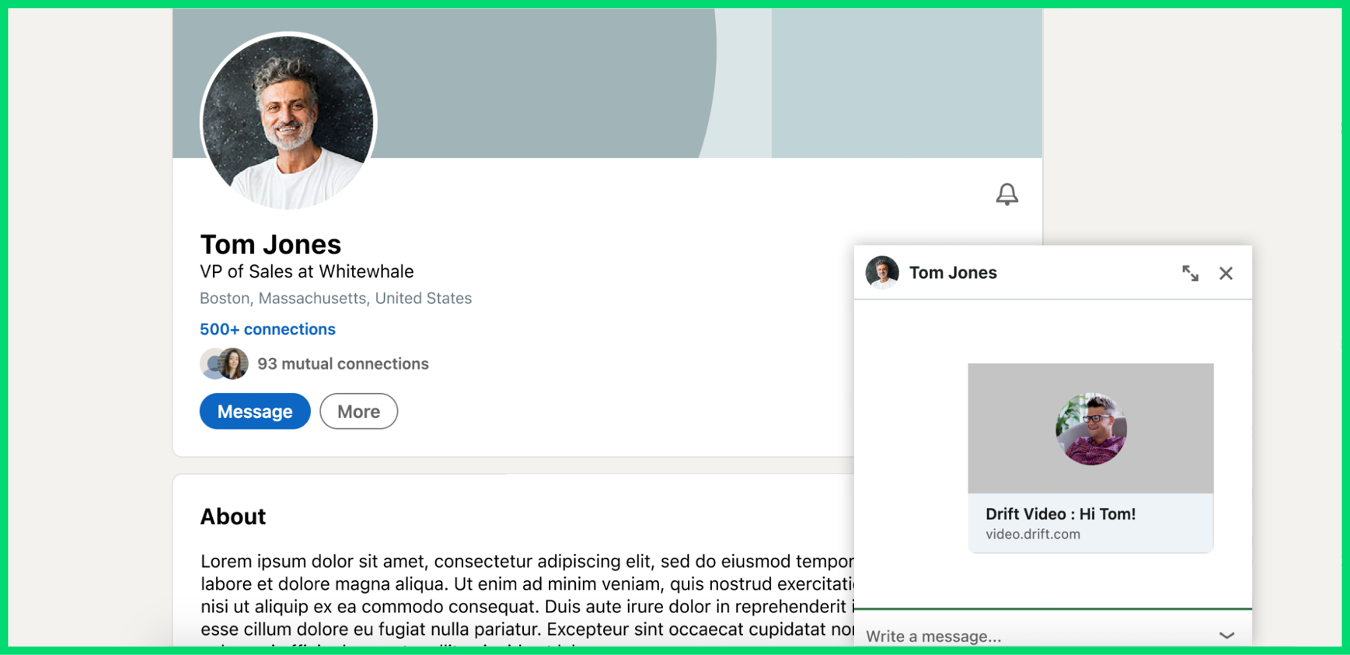
Drift for Deal Management
There are a lot of activities, accounts, and overflowing inboxes competing for your sales team’s attention on any given day. You want to set up a GTM strategy that gives them an easy way to identify target accounts, engage with them, and move them down the funnel.
Whether it’s identifying decision-makers, crafting the perfect outreach, or responding to high-value accounts in real-time, your sales team can use Drift to manage deals and accelerate revenue.
“I use Drift as my compass throughout the day, whether it’s at the top of the funnel for outbounding or further down the funnel for deal management.”
— Taylor Slesinksi, Account Executive, Drift
Identify Your Buying Committees & Prioritize Target Accounts
Most B2B buying journeys are messy. Today, the average buying committee has between six to 10 decision-makers. This means you need a strategy that enables you to sell to multiple personas and customize your message for each person.
Drift Deal Room is a single source of truth for you and your buyers which stores all your past communications, notes, and resources. It’s a place where you can collaborate with the buying committee to make faster decisions by removing friction, promoting transparency, and easily aligning at every step of the sales process.
With Deal Room you can:
- Streamline conversations: Even the best systems can break down and you just might be left with a very full inbox, making it easy to miss messages and important communications. With Deal Room, you can automatically store meeting recordings, shared files, and more — and easily find them when you need them.
- Collaborate efficiently: Deal Room keeps everything in one place from to-do lists to conversations. You can comment on messages, check off items in your mutual action plan, and even enable buyers to start a chat with you with one click.
- Communicate effectively: You can invite both your selling team and the buying committee to Deal Room, increasing transparency and reducing redundant work.
Engage with Target Accounts
As a sales rep, you want to reduce the amount of back-and-forth with your buyers. To do this, you need a frictionless way to convey information and make it easy for buyers to respond. One of those ways of course, is Drift Video.
But what if a target account comes to your website?
Earlier we shared how Drift ABM allows you to personalize chat messaging for buyers. Like with Drift Video, Drift ABM will notify sales when a contact from a target account is on your site. If those buyers want to book some time with you, you can use Drift Meetings to share your calendar seamlessly in chat. This way, you’ll never have to worry about missing out on a high-priority account.
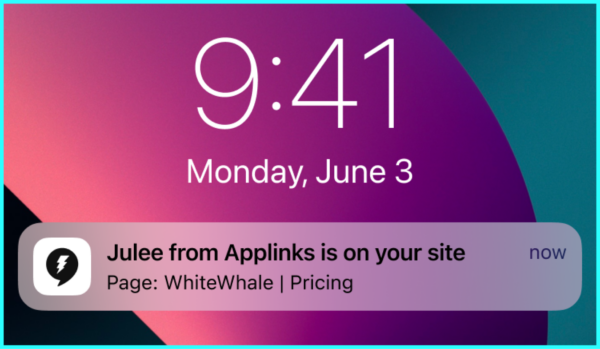
Conversational Sales allows you to meet each buyer where they are in their journey, while accounting for the complex selling processes of today. It’s designed to be personal, efficient, and effective.
If you’re the Drift Admin for your organization, you are probably working across your entire organization to implement, run, and measure Drift.
In this chapter, we are going to look at ways that you can connect Drift with your tech stack, work efficiently with sales and marketing teams, and measure and report on Drift’s performance.
Adding Drift to Your GTM Tech Stack
We built Drift with integrations in mind. That’s why we’re adding new integrations all the time and making it easy for customers to connect Drift with the tools they already have in place.
In other words, we’re not here to change the way your GTM teams work but to help make their work better. It’s how we think about using Drift here, and it’s how we hope you see Drift fitting into your tech stack too.
To get the most out of Drift right away, you’ll want to properly integrate it into your GTM tech stack. Here are the high-level steps for doing just that:
- Look at your existing GTM strategy: Before you dive into the technical stuff, think about how leads get delivered to your sales team now. Identify how leads are passed off and where Drift fits into that workflow. That way, you can build on what your team already has in place.
- Decide how Drift will connect to your other tools: Drift makes it easy to connect with your most important tools. To start, you want a bi-directional sync between your Drift instance and your CRM and MAP. With this bi-directional sync, you create a seamless, real-time user experience. You can learn more about Drift’s two-way integrations here.
- Meet with your marketing, sales, and service leaders: Meet with your marketing, sales, and service leaders to ensure everyone comes to an agreement about what changes need to be made to your GTM process and how team members will be using Drift in their day-to-day.
Now that you’ve laid your foundation, you can start layering on your additional integrations.
Integrations for Marketing, Sales, Service, and More
Drift wants to support all of your revenue teams. And these teams have different tools they lean on every day. That’s why we offer more than 50 integrations to support your needs, including integrations for:
We won’t dig into every Drift integration available (we’d be here a while). Instead, we’ll share some common integrations our customers use every day:
Drift + Salesforce Integration
There’s a lot of rich data in a Drift conversation — insights your sales and marketing team need to target buyers and close deals.
With Drift’s two-way Salesforce integration, you can sync Drift chat data directly to Salesforce. This gives your team real-time insights and lets you automatically route conversations with existing leads to the right account owners.
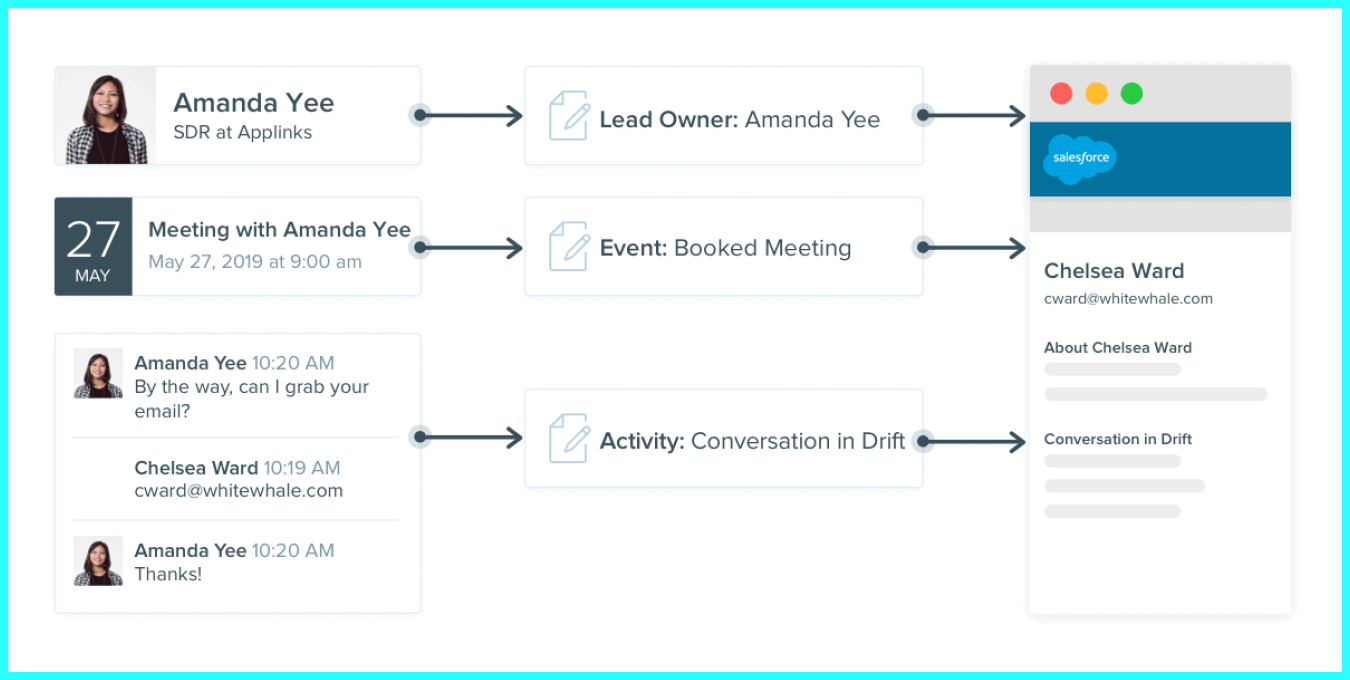
You can also sync contacts from your target accounts from Salesforce to Drift so you know who your VIP buyers are and can greet them with personalized messaging.
Finally, your Drift + Salesforce integration also comes with robust reporting features. These reports show how Drift impacts your bottom line. Drift does this by automatically syncing with opportunities in Salesforce to analyze:
- Which opportunities were influenced by Drift
- The dollar value of those opportunities
- Which Drift conversations influenced those opportunities
We’ll share more details about Drift + Salesforce reporting features in the last section of this chapter.
Drift + Marketo Integration
If you’re running an ABM program, you’ll want to check out our Drift + Marketo integration. With this two-way integration, you can personalize your outreach in chat and make your existing Marketo campaigns even smarter.
Drift enriches your Marketo database with Drift insights. This creates a seamless customer experience across your different marketing channels.
Drift + Salesloft Integration
We’ve talked about ABM enough in this guide to get the point across: It’s a significant part of the most successful GTM strategies.
The Drift + Salesloft integration provides immediate visibility into target account activity to arm you with the information you need to deliver more personalized experiences. In addition, this integration allows you to:
- Get real-time notifications to immediately start a conversation
- Level up your ABM strategy with hyper-personalized and timely messaging
- Enroll contacts in Salesloft cadences and monitor activity in one intuitive dashboard
Drift + Outreach Integration
How many emails does your sales team send out every week? How about every day?
A lot, we bet.
That’s why so many sales teams rely on our Drift + Outreach integration.
Instead of waiting to see which buyers engage with an email, your sales team is immediately notified when a buyer clicks on an email link and lands on your website. If the sales rep happens to be tied up at that moment, the Drift chatbot can cover for them and book a future meeting.
But what if a buyer isn’t ready to book a meeting? In that case, the sales team can enroll the buyer in their Outreach sequence to nurture them further. The information from your Drift chat is then synced into Outreach’s activity feed. So, when a buyer does eventually jump on a call with sales, your reps can reference past conversations they’ve had with that buyer.
Now that you’ve set up your key integrations, you can start reporting on how Drift is influencing your bottom line.
Measuring Drift’s Impact on Your Business Revenue
Drift’s revenue reports are powered by the Drift for Salesforce App. With this app you can:
- See your Drift conversation data within Salesforce so you have the flexibility to choose how you want to do revenue reporting
- Push this data to other systems (like Looker or Snowflake) along with the Salesforce data that you already push
- Hit the ground running with pre-built revenue dashboards and reports

Drift’s pre-built reports and custom dashboards give you an at-a-glance view of your performance so you always have the information you and your stakeholders need right at your fingertips. You can also use the app to analyze your performance across the business, by a specific metric or by teammate. This way, you can easily identify areas that you should improve or double down on.
Overview Report
The overview report is exactly what it sounds like: It provides an overview of your success with your GTM strategy via revenue metrics — all on one page. In this report, you can see:
- The total amount of deals and opportunities
- The top opportunities by revenue
- The biggest deals Drift has helped you close
- The total revenue Drift has helped you close
- How quickly Drift is helping you close deals and revenue
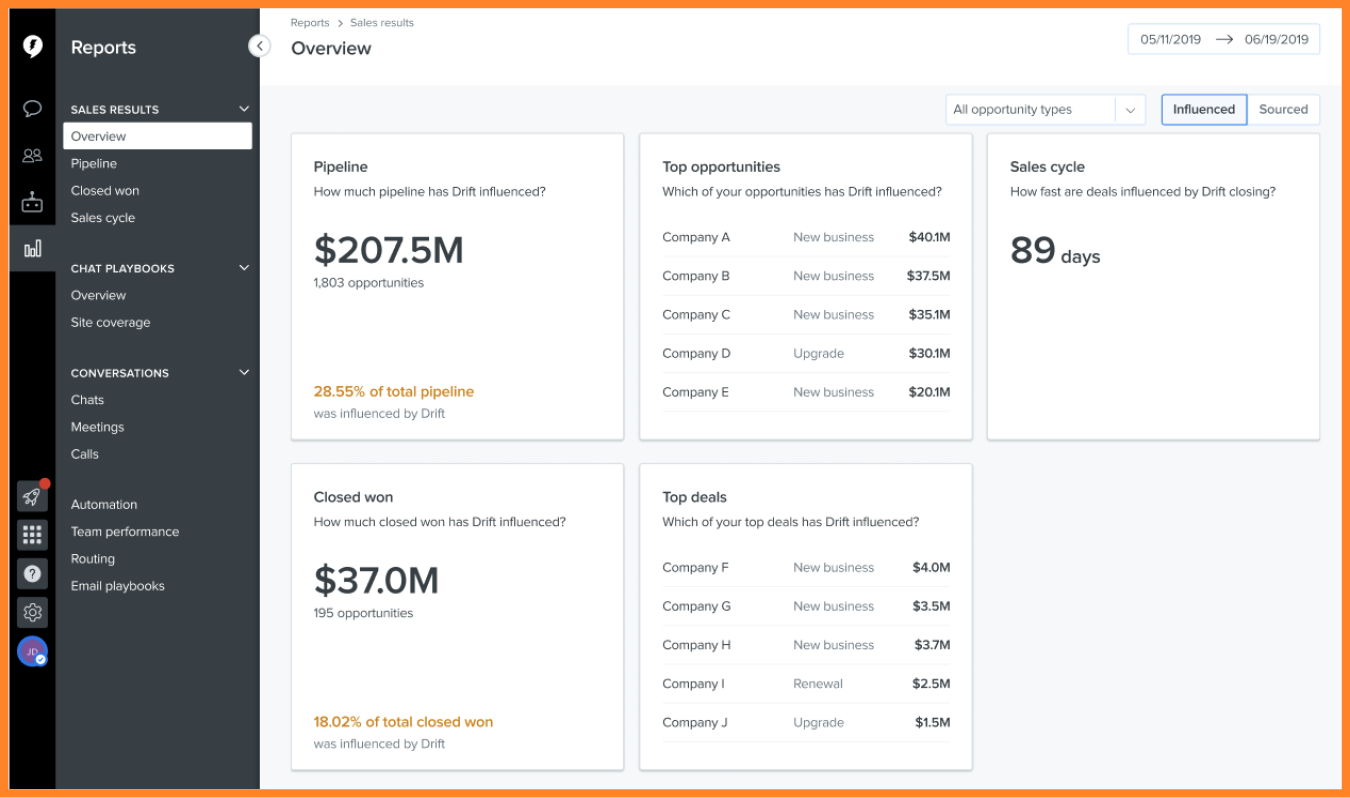
You can then filter the data displayed here by influenced and sourced:
- Sourced: This refers to the first time a contact from an account interacted with your company via Drift.
- Influenced: This refers to every other time a contract from an account interacted with your company via Drift.
From this view, you can also access the three other revenue reports as well.
Pipeline Report
The pipeline report identifies how much potential revenue Drift has influenced for your business. As we saw in the overview report — and as we’ll see with the other revenue reports — this information can be filtered by influenced and sourced.
You can also filter by the type of opportunity (i.e. new business, expansion, etc.). This makes it a valuable report for your marketing, sales, and service teams.
Closed Won
Your closed won report shows exactly how much revenue Drift has helped your business close over a period of time.
Sales Cycle
A successful GTM strategy is all about shortening your sales cycle and accelerating revenue. And with the sales cycle report, you can see the average number of days between the creation and closure date of Drift-influenced opportunities.
Tracking Your Performance with Drift
Drift offers even more insights and analytics to help you optimize your website engagement, marketing, and sales strategy.
Chat Playbook Reports
To increase the number of conversations you have, meetings you book, and leads you capture, you need to stay on top of your chat playbook performance.
Drift’s chat playbook reports help you understand your top-performing playbooks, the coverage of playbooks on your site, and individual playbook performance. These reports cover five metrics:
- Impressions: The number of times a playbook is shown to a website visitor.
- Sends: The number of website visitor sessions where a playbook was shown.
- Conversations: The number of conversations started by a playbook — from clicking a button in a playbook to chatting with a bot or human.
- Emails captured: The number of new emails captured by a playbook.
- Meetings booked: The number of meetings booked in conversations that started with a particular playbook. This counts for both meetings booked by bots and humans.
There are two main reports that fall under here: the overview and site coverage reports.
The overview report shows the top 25 playbooks by performance on your website. From here, you can dig into each playbook’s performance based on the five metrics we mentioned earlier. This report will calculate your conversation rates for each playbook, making it easy to compare playbook performance.
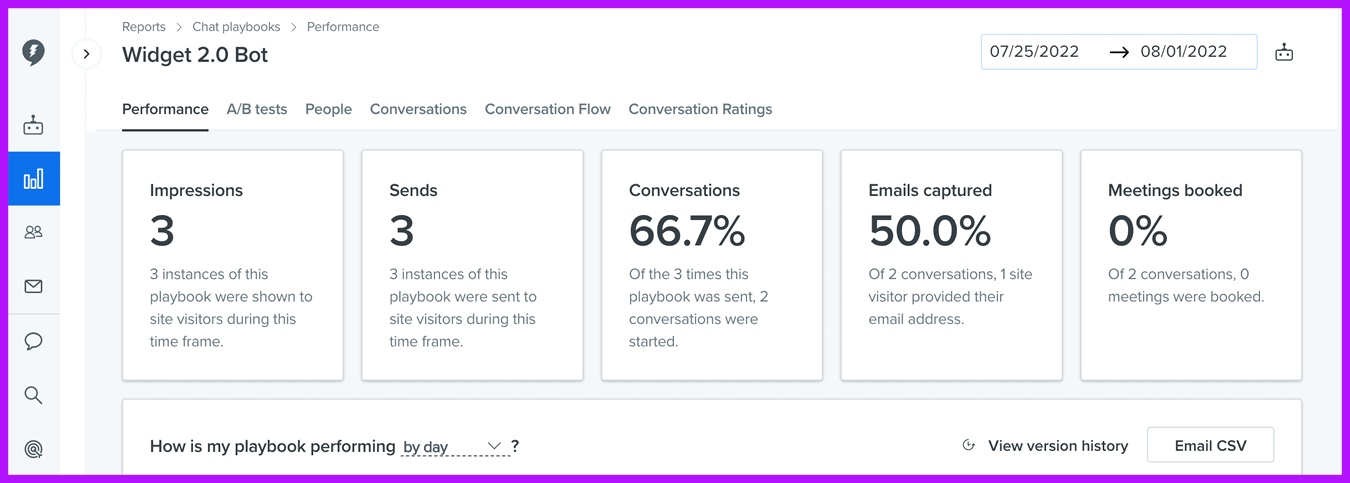 Finally, there are several tabs located at the top of this report that let you dig even deeper:
Finally, there are several tabs located at the top of this report that let you dig even deeper:
- People: See who has interacted with your playbook (both known and anonymous).
- Conversations: Drill down into the conversations people have had with your playbook.
- Conversation Flow: See the different paths people took with your playbook. This is useful for identifying where drop-offs might be happening.
- Conversation Ratings: There’s an option to turn on “conversation ratings” for your playbooks. With this feature, website visitors can rate their experience with a bot or human they interacted with for a particular playbook.
The site coverage report shows the average playbook coverage on your website, the highest covered page, and the lowest covered page. You can then drill down into those pages and see the total number of visitors per page, the total number of visitors who have been shown a playbook, and the number of playbooks firing on each page.
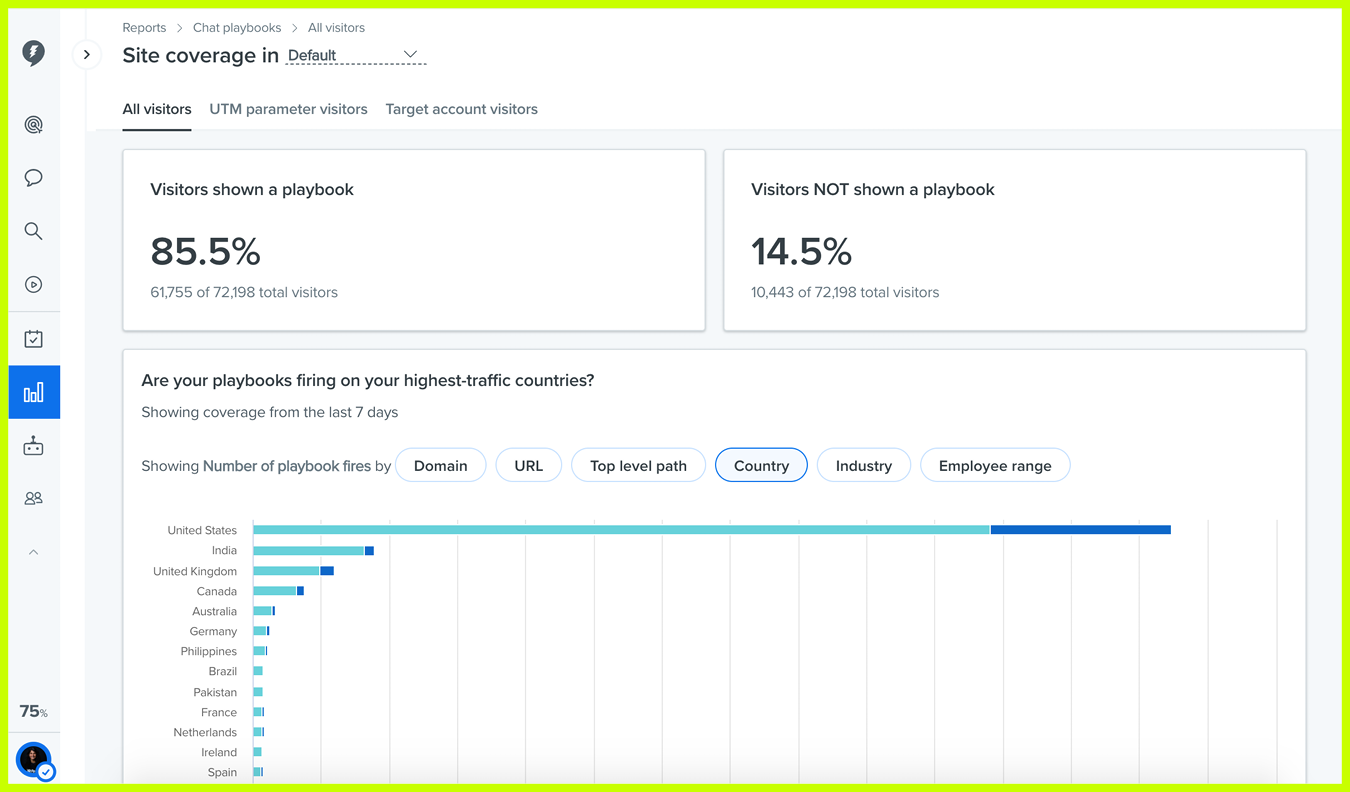
Conversations and Performance Reports
Conversations Reports show all the conversations your team has had with buyers and customers. Here, you can analyze bot conversations, human conversations, or all conversations.
There are four different reports found here: chats, meetings, calls, and conversation analysis. These individual reports help you understand:
- New conversations and conversations by the time of day
- Where conversations are happening
- How conversations are being tagged
Team Performance reports help you understand:
- How your team is performing
- Who is responding to the most conversations
- The routing rules you have in place
Looking at how many new conversations are started per day and where those conversations are happening helps revenue teams better target buyers and customers on your website.
Additionally, sales and SDR managers can use the team performance report to evaluate their rep’s interactions with website visitors. They can see the median response time across the site, how many visitors each rep is having conversations with, and how visitors are rating those conversations.
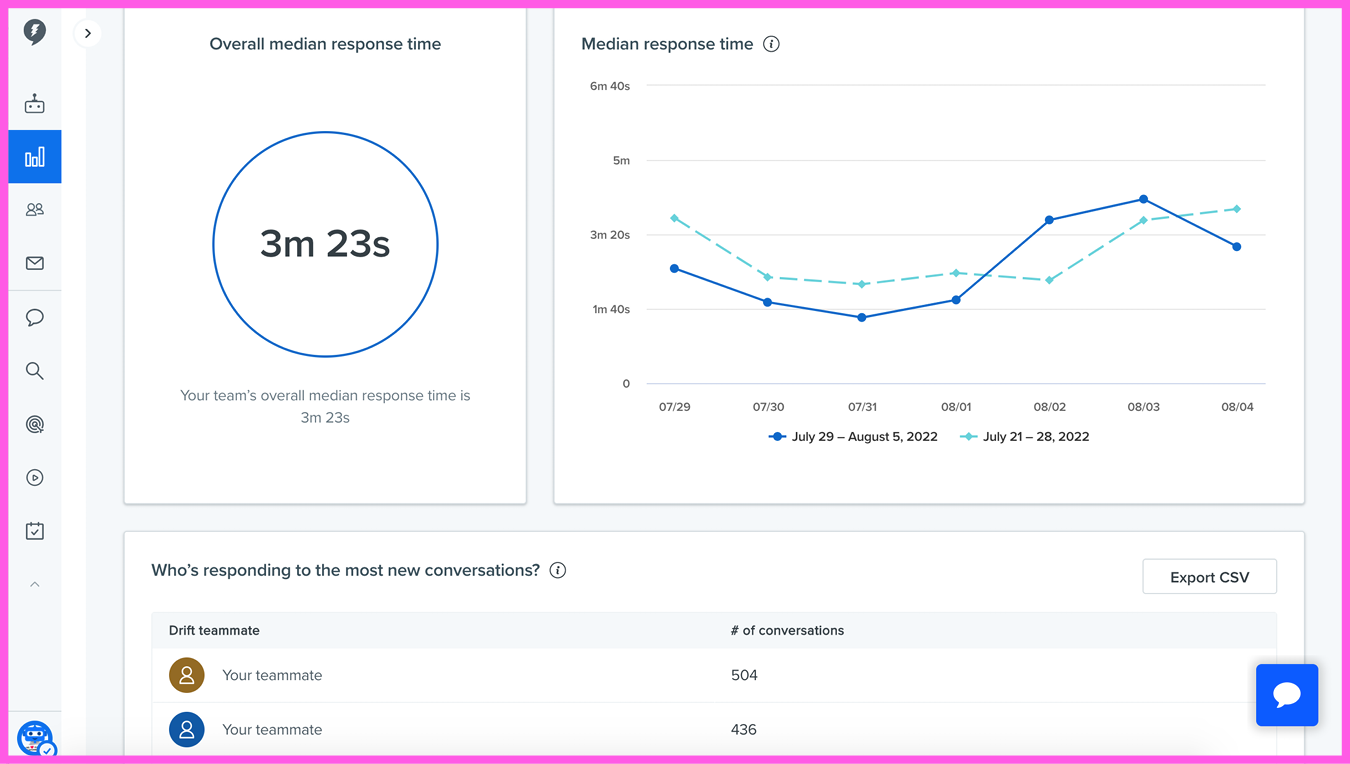
The routing report is popular with marketing and sales operations managers. Here you can see where conversations are being routed. Lead routing rules are set from the lead routing tab; from there you can set up custom routing rules for your sales team. Clicking into these rules reveals how many conversations were routed to each sales rep.
As we all know, you can only improve what you can measure. We hope the insights in this chapter make your Drift integrations and setup more seamless so that you can experience success with a Drift GTM strategy.






















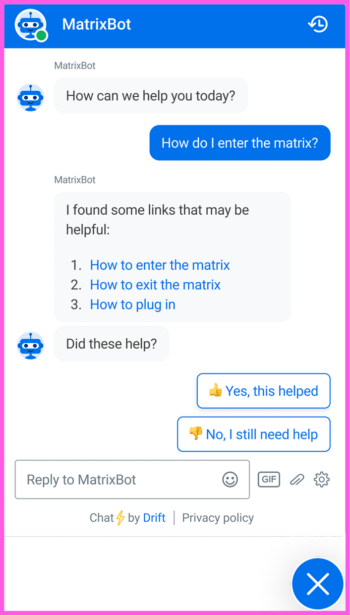



 Finally, there are several tabs located at the top of this report that let you dig even deeper:
Finally, there are several tabs located at the top of this report that let you dig even deeper:
